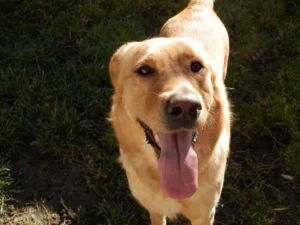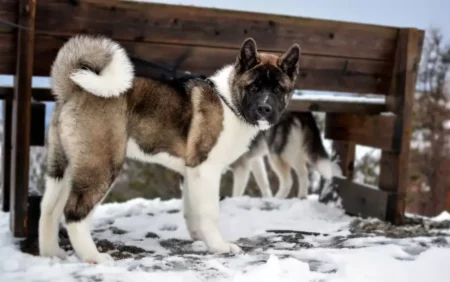If you’re the proud owner of an Akita dog, you know how loyal and protective they can be. However, owning an Akita also comes with its own set of challenges, especially when it comes to training. In this blog post, we’ll explore the various techniques and tips to help you train your Akita effectively.
Contents
Overview of Akita dogs
Akita dogs are a large breed of Japanese dogs initially bred for hunting and guarding purposes. They are known for their thick, fluffy coats and powerful builds and can weigh up to 130 pounds. Akitas are intelligent, independent, and fiercely loyal to their owners.
Training is essential for all dogs, but it’s necessary for Akita dogs. Akitas can be stubborn and have a strong will, making training challenging. They can become aggressive and difficult to handle without proper training, which can be dangerous for their owners and others.
Purpose of the blog post
This blog post aims to provide a comprehensive guide on effectively training your Akita dog. We’ll cover everything from basic training techniques to more advanced methods, common training issues, and tips for success. By the end of this post, you’ll have all the tools and knowledge you need to train your Akita and build a strong, positive relationship with them.
Understanding Your Akita Dog
Akita dogs are a fascinating breed known for their loyalty, courage, and intelligence. However, to train an Akita dog effectively, it is essential to understand its characteristics, temperament, behavior, and communication patterns.
Characteristics of Akita Dogs
Akita dogs are large, powerful, and muscular, with a thick double coat in various colors, including white, brindle, red, and sesame. They have a broad head, pointed ears, and curled tails, which are distinctive features of the breed.
Here are some of the physical characteristics of Akita dogs:
- Height: 24 – 28 inches (males), 22 – 26 inches (females)
- Weight: 75 – 120 pounds (males), 70 – 110 pounds (females)
- Lifespan: 10 – 13 years
Temperament and Behavior of Akita Dogs
Akita dogs are renowned for their loyalty, courage, and protectiveness toward their owners. They are independent thinkers and can be stubborn, so it is crucial to establish yourself as the pack leader from an early age.
Here are some of the standard temperament and behavior traits of Akita dogs:
- Loyal and protective of their family
- Reserved and aloof with strangers
- Can be aggressive towards other dogs of the same sex
- Independent thinkers can be stubborn
- Require early socialization and training to avoid aggressive behavior
Communication with Your Akita Dog
Akita dogs have a unique way of communicating with their owners, which involves body language, vocalization, and facial expressions. Understanding your Akita dog’s communication patterns can help you build a stronger bond with them and train them more effectively.
Here are some of the ways that Akita dogs communicate:
| Communication | Description |
|---|---|
| Body Language | Stiff posture, raised hackles, and a curled tail indicate aggression or dominance. A wagging tail, relaxed posture, and soft eyes indicate friendliness and submission. |
| Vocalization | Akita dogs are not known for excessive barking but may growl or bark when they perceive a threat or danger. |
| Facial Expressions | Akita dogs have expressive faces that show their emotions. They may show a furrowed brow, wrinkled nose, or flattened ears when upset or angry. |
Understanding your Akita dog’s characteristics, temperament, behavior, and communication patterns is crucial to training them effectively. With proper socialization, training, and communication, you can build a strong bond with your Akita dog and enjoy a lifetime of companionship.
Basic Training Techniques for Akita Dogs
When training your Akita dog, starting with the basics is essential. This section will cover some of the most effective basic training techniques for Akita dogs. These techniques will help you establish a foundation for more advanced training later.
Positive Reinforcement Training
Positive reinforcement training is a highly effective training technique for Akita dogs. This technique involves rewarding your dog for good behavior rather than punishing them for bad behavior. Rewards can include treats, praise, and playtime. By using positive reinforcement, you can encourage your Akita to repeat good behavior and learn new commands.
Clicker Training
Clicker training is a form of positive reinforcement training that uses a clicker to mark the desired behavior. The clicker is a small device that makes a clicking sound when pressed. When your Akita performs a desired behavior, you click the clicker and reward them with a treat. Over time, your Akita will learn to associate the click with the reward and begin to perform the desired behavior independently.
Leash Training
Leash training is an essential skill for any dog, including Akita dogs. Begin by introducing your Akita to a leash and collar, and let them wear it around the house. Once your Akita is comfortable with the leash and collar, you can take short walks outside. Be sure to reward your Akita for good behavior on the leash, such as walking calmly beside you.
Crate Training
Crate training is famous for many dog owners, including those with Akita dogs. A crate can provide your Akita with a safe, comfortable space to relax and sleep. Start by introducing your Akita to the box and letting them explore it independently. Gradually increase the amount of time your Akita spends in the crate, and reward them for entering the container voluntarily.
Housebreaking
Housebreaking, or potty training, is essential for any dog owner. Establish a consistent routine for taking your Akita outside to go potty. Reward your Akita for going potty out, and supervise them closely when inside to prevent accidents. Over time, your Akita will learn to ask to go outside when they need to go potty.
These basic training techniques are essential for any Akita dog owner. By using positive reinforcement, clicker training, leash training, crate training, and housebreaking, you can establish a strong foundation for more advanced training later on. Remember to be patient and consistent with your workout and reward good behavior. Your Akita will become a well-behaved and obedient companion with time and practice.
Advanced Training Techniques for Akita Dogs
As Akita dogs are known for their intelligence and loyalty, advanced training techniques can help develop their skills and abilities. In this section, we will discuss some advanced training techniques that can be used to train Akita dogs.
Obedience Training
Obedience training is essential for Akita dogs as it helps them learn basic commands, such as sit, stay, come, and heel. This training helps establish a bond between the dog and its owner, and it also helps increase the dog’s confidence and socialization skills.
Agility Training
Agility training involves teaching your Akita dog to navigate through an obstacle course of tunnels, jumps, and weave poles. This training helps improve the dog’s agility, coordination, and overall physical fitness.
Protection Training
Protection training involves teaching your Akita dog to protect you and your property when needed. This training is only suitable for some Akita dogs and should only be done under the supervision of a professional trainer. However, it can help increase the dog’s confidence and sense of responsibility if done correctly.
Socialization Training
Socialization training is essential for Akita dogs as they can be territorial and may not get along with other dogs. This training involves exposing your Akita dog to other dogs, people, and new environments, helping them learn to interact positively with others.
Tips for Advanced Training Techniques
- Use positive reinforcement training techniques to motivate your Akita dog
- Be patient and consistent in your training
- Start training at a young age for the best results
- Use high-value rewards such as treats and toys to encourage your Akita dog
- Seek professional help when needed
Advanced training techniques can help develop your Akita dog’s skills and abilities. However, it’s essential to remember that not all dogs are the same, and some may require more specialized training. With patience, consistency, and proper guidance, you can successfully train your Akita dog and strengthen your bond with your furry friend.
Common Training Issues with Akita Dogs
Akita dogs are known for their loyalty and protectiveness toward their owners. However, they can also exhibit specific behavioral issues that require proper training and attention. This section will discuss some joint training issues that Akita dogs may show and how to address them.
Aggression toward other dogs
Akita dogs have a strong prey drive and can be aggressive toward other dogs, especially those of the same sex. This behavior stems from their history as hunting dogs and their territorial nature. Socializing your Akita dog from a young age is essential to address aggression towards other dogs. This will help them learn appropriate behavior around other dogs and reduce their tendency to become aggressive. Additionally, obedience training and positive reinforcement can help control their behavior around other dogs.
Separation anxiety
Akita dogs are known for their strong attachment to their owners and can become anxious when left alone. Separation anxiety can lead to destructive behavior, excessive barking, and even injuries if they try to escape. To address separation anxiety, it is essential to gradually acclimate your Akita dog to being alone. Start by leaving them alone for short periods and progressively increasing the duration. Providing them with toys, treats, and comfortable spaces can also help to reduce their anxiety.
Excessive barking
Akita dogs are vocal animals prone to excessive barking, especially when they feel threatened or anxious. To address excessive barking, it is essential to identify the triggers that cause your Akita dog to bark. This can include visitors, other animals, or noises outside. Once you have identified the triggers, you can work on desensitizing your dog to them through positive reinforcement and consistent training. Additionally, providing your Akita dog with sufficient exercise and mental stimulation can also help to reduce their tendency to bark excessively.
Destructive behavior
Akita dogs are potent animals prone to destructive behavior, especially if not adequately exercised or stimulated. Violent behavior can include chewing, digging, and scratching furniture or walls. Providing your Akita dog with sufficient exercise and mental stimulation is essential to address lousy behavior. This can include daily walks, interactive toys, and training activities. Crate training can also help prevent destructive behavior when you are not home.
Addressing these common training issues can help your Akita dog become a well-behaved and obedient companion. Remember always to use positive reinforcement and consistency in your training efforts. If you are experiencing difficulty in training your Akita dog, seek the assistance of a professional dog trainer.
Tips for Successful Training of Akita Dogs
When training your Akita dog, consistency and patience are crucial. With their natural independence and strong-willed personality, it can take time to see progress in their training. However, following these tips can set yourself and your Akita up for success.
Consistency and Patience
Consistency is vital when it comes to training your Akita. Stick to a regular training schedule and use the same commands and techniques each time. This will help your Akita understand what is expected of them and make the training process more effective.
Patience is also essential when training your Akita. These dogs are sometimes stubborn, and progress may take longer than expected. It’s important to stay calm and patient during training and not get frustrated with your dog.
Start Training Early
Starting training early is essential for all dogs, especially Akita dogs. These dogs have strong personalities and can be more challenging to train as they age. Start preparing your Akita as soon as possible, even if it’s just basic obedience commands like “sit” and “stay.”
Proper Exercise and Nutrition
Proper exercise and nutrition are essential for your Akita dog’s health and well-being. These dogs have high energy levels and require regular exercise to stay happy and healthy. Ensure your Akita gets plenty of activities daily, whether a long walk or a run in the park.
A healthy diet is also essential for your Akita training. Ensure they get a balanced diet that includes high-quality protein and nutrients. Consult with your veterinarian to determine the best diet for your Akita.
Seek Professional Help if Needed
If you need help with your Akita’s training, seek professional help. A professional dog trainer or behaviorist can provide guidance and support to help you and your Akita overcome any training obstacles.
Training an Akita dog can be challenging, but with consistency and patience, you can see progress. Preparing early, providing proper exercise and nutrition, and seeking professional help are essential to successful Akita training. Following these tips can help your Akita become a well-trained and well-behaved companion.
Frequently Asked Questions
1-Are Akitas high-risk dogs?
Akitas are considered high-risk dogs due to their solid and independent nature, which can lead to aggression toward other animals and humans if not properly trained and socialized.
2-Do Akitas shed a lot?
Yes, Akitas are known for shedding a lot, especially during their seasonal shedding periods in the spring and fall.
3-Are Akita and Shiba Inu the same?
No, Akita and Shiba Inu are not the same. While they share some physical and personality traits, they are separate breeds with distinct characteristics and histories.
4-What are Akita dogs known for?
Akita dogs are known for their loyalty, courage, and protective nature. They were initially bred in Japan to hunt large game such as boar and bear and are also used as guard dogs and family companions. Akitas are recognized for their distinctive appearance, including their thick double coat, bear-like head, and curled tail.
Conclusion
As a responsible pet owner, it is essential to train your Akita dog. With their strong-willed personality and intuitive nature, training can help establish a healthy and happy relationship between you and your furry friend. In this guide, we have covered the basic and advanced techniques of training your Akita dog. Let’s recap the key points and encourage you to prepare your Akita dog today!
Recap of Key Points
- Understanding your Akita dog is the foundation of training. Knowing their characteristics, temperament, and communication style will help you tailor your training techniques accordingly.
- Basic techniques such as positive reinforcement and leash training are essential for establishing good habits and behavior.
- Advanced training techniques such as obedience, agility, protection, and socialization can help your Akita dog become well-rounded.
- Standard training issues such as aggression, separation anxiety, excessive barking, and destructive behavior can be addressed with proper training techniques and professional help.
- Consistency and patience, starting training early, providing proper exercise and nutrition, and seeking professional help are all essential factors in successful training.
Encouragement to Train Your Akita Dog
Training your Akita dog can be a fun and rewarding experience for you and your pet. It can strengthen the bond between you and your dog, establish good behavior, and provide mental stimulation. By investing time and effort in training, you will have a well-behaved and happy pet that can bring joy to your life.
Final Thoughts and Resources for Further Reading
We hope this guide has provided valuable information on training your Akita dog. Remember that training is an ongoing process requiring patience and consistency. If you encounter any challenges, seek professional help to address them. We recommend checking out the American Kennel Club’s resources on Akita dogs and training techniques for further reading. Happy training!










